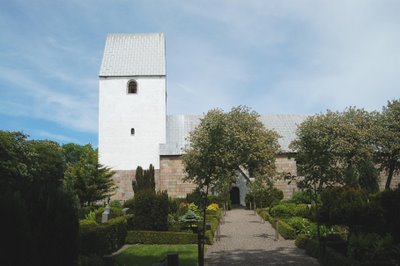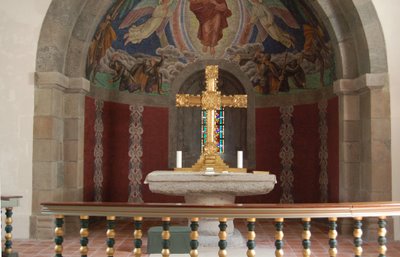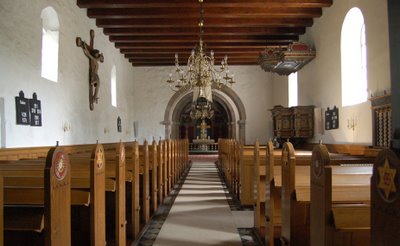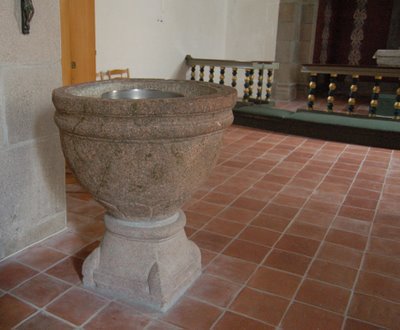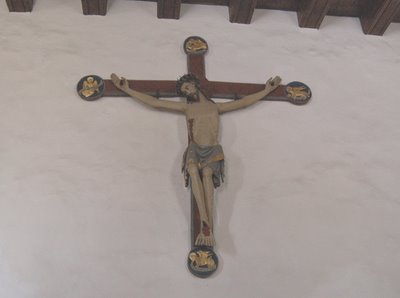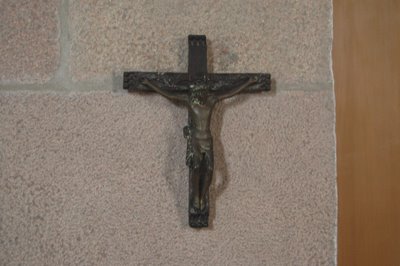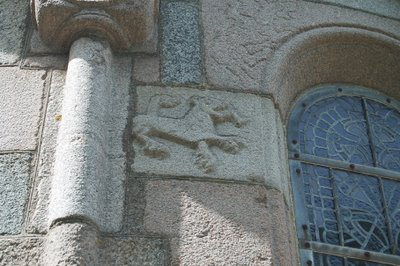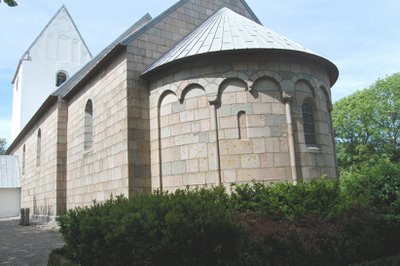
Veggerby Church, Hornum herred Ålborg amt.

Svenstrup Church, Onsild herred, Randers amt.

Grinderslev Church, Salling, Nørre herred, Viborg amt.
Grinderslev Church belonged originally to Grinderslev Augustine closter built in the middle of the 12th century. A chess pattern like this is seen on the walls of several Danish churches, especially in North Jutland. They were interpreted in many ways, i.e. the stone master's spare-time occupation - repair of stone damage or spreadsheet - mysterious symbolic numerals or messages and finally interpreted as the symbol of white/black, good/evil and life/death. Popular name is "Devil's Board Game", which means that a human is playing with death about the time of his leaving this world. The legend also says that the Devil often disturbed the church building by tearing down at night what had been built at day. The building master then would make a game board for the Devil, who in his gambling mania would be so occupied that the building could remain undisturbed.

Bejstrup Church, Nørre Han herred, Hjørring amt.
Skallerup church, Vennebjerg herred, Hjørring amt.
In a work from the National Museum about Danish churches a Danish historian M. Mackeprang , once the director of the National Museum, wrote about the chess boards. At that time he counted 22 churches with chess boards, mainly from North Jutland. Later in 1983 the number was increased to 35. The spreading of the chess boards shows a marked attachment to North Jutland, and outside this area are only known one at Bornholm (Povlskirken ) and a few in Norway and Sweden. But some people thought it was still not investigated properly, so a Jutland newspaper, Jyllands-Posten, started a research - the result was some ten new examples, which did not disturb the original picture though. Up to date 45 churches in Jutland are registered with chess boards, six churches have two examples and four have three examples, the full amount is 59.

Gøttrup church, Vester Han herred, Thisted amt.
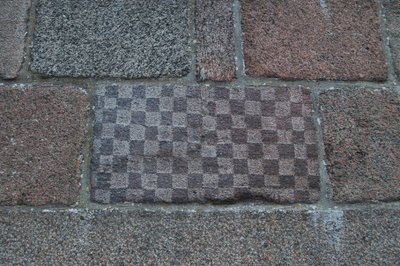
Nors church, Hillerslev herred, Thisted amt.
Text below is from an article by Jens Vellev in archaeological magazine Skalk 1/1988.
"The placing of the chess boards upon the church walls seem random chosen, but rebuildings and replacements might have changed things essentially. The chess pattern varies in form and size, the biggest is 53x132 cm. The 8x8 squares, like a common chess board, seem to exist in only one example. The chess boards are found both in squares and rectangles. The inner small squares are sometimes surrounded by other geometric figures, triangles, circles and alike - and these also fill in areas at times. South of Aarhus and in a straight line to Thyborøn by the North Sea there isn't one example of a chess board upon a church, neither in south Jutland or at the islands, except for one example at Bornholm. The chess board in Povlskirken at Bornholm is 8x8 squares, but just below is another carving, a complete perfect example of, what we today know as Backgammon. This really looks as if the stone mason meant it to be a board game. The carved ashlar is of the same black silurchalkstone from which the church was built, so nothing suggests that this board game wasn't there from the beginning.
Chess boards of the North Jutland type are seen in a few Swedish and Norwegian churches, i.e. Rydaholm in Sweden, and three in Norway, all situated in Østfold. In one of the Norwegian churches is furthermore found an ashlar with the runic inscription "Odinkar", a name which in Norway is known only from this one find, while it was common in Denmark in the Viking period and the Middle Ages. The chess boards are early medieval, but it is not possible to give some exact limitation about the dating - since the dating of just one example often causes trouble. How did they arise, and what do they mean? They cannot be one man's work, although it sometimes happens that local ideas set a fashion.

Kettrup Church, Vester Han herred, Thisted amt.

Hillerslev church, Hillerslev herred, Thisted amt.
In a frescoe in Täby church north of Stockholm a worrying gentleman is playing a board game with a smiling spectre - a remind to the viewer not to forget life's corruption; "The Devil's Board Game" might have had a similar mission, but this explanation suits best for the example at Bornholm, which is of quite another character, it seems to be of another root than in North Jutland. They remind about each other, but the differences exclude that it is a particular game. Other possibilites must be taken in consideration. In the Apocalypse, chapter 21, the Heavenly Jerusalem is described with an exact specification of a long row of measures. A Spanish handwriting from the 900-years shows the city - not upstanding as normally, but flattened - with twelve gates around a chess patterned place. The illustration is somewhat older than the chess boards in the churches mentioned here, but a connection cannot be excluded. There is no certain interpretation, but it is certain that the chess boards had a very particular purpose, and sooner or later it might be traced."
